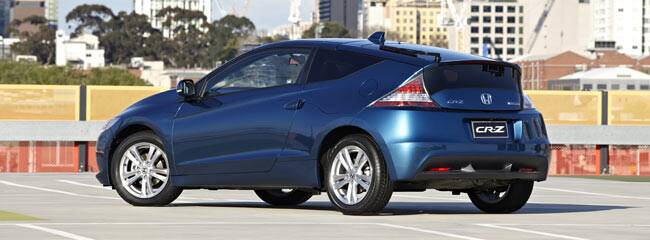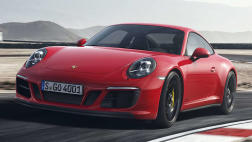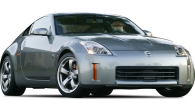Petrol/electric hybrid cars have been on Australian roads since March 2001 when the Honda Insight was released.
These early hybrids were very much the domain of government bureaucrats keen to show off their green credentials as they shuffled themselves around between meetings. The fact that taxpayers and ratepayers were footing the bill for the $15,000-plus extra cost above those of similarly-sized cars also helped.
We often talk of cars that bring a smile to the face of the driving enthusiast. Well these early hybrids brought little more than a glum look. Later arrivals, from Honda, as well as Toyota and Lexus, added more charisma but not a great deal more performance.
Then, in late 2011, came what could well be a turning point in the hybrid scene with the arrival of the all-new Honda CR-Z, billed as the world’s first hybrid sports coupe and a real surprise packet, not just to us but also to the ‘Wheels’ magazine judges who selected it as their 2011 Car of the Year.

Design
Styling of the Honda CR-Z is distinctive enough to attract quite a bit of attention from fellow road users. The rear glass roof and chopped off tail are reminiscent of the old Honda CR-X and the original Insight. However we were disappointed with the horizontal split panel arrangement of the rear windscreen which provides poor. Drivers who don’t adjust their door mirrors correctly could get themselves into strife.
While CR-Z can seat four, the rear seats have minimal legroom when the front seats are well back and it’s best considered as a 2+2 with the rear seats only there for emergencies. Still, it is a sports coupe so being a 2+2 is barely a criticism.
Front leg, shoulder and headroom are all fine. Luggage space, an issue with early hybrids because of the space required for the larger batteries of that era, is reasonable at 225 litres, expanding to 401 litres with the rear seatback folded, something again that hasn’t always been available in hybrids.
Engine and mechanical
Power for the Honda CR-Z comes from the combination of 1.5-litre i-VTEC petrol engine and Honda’s Integrated Motor Assist (IMA) electric system. Maximum power output for the combined petrol/electric system is 91 kW with peak torque of 174 Nm (manual) or 167 Nm (CVT). The latter are the important figures and would normally require a petrol engine of around 1.8 litres.
Fuel consumption on the combined cycle Australian Standards test is 4.7 litres per 100km with the CVT and 5.0 L/100 km with the manual gearbox. CO2 emissions are measured at 118 grams per km (manual) and 111 g/km (CVT) with that fuel usage.
On test our fuel consumption was 6.3 L/100 km, an impressive figure given that we made no real attempt at economy driving. Honda CR-Z has a three-mode drive system (Sport, Normal and Economy) which controls steering, throttle response and IMA assistance.
‘Sport’ mode increases throttle and steering responsiveness and increases electric motor power assistance. ‘Economy’ mode tunes the system for optimal fuel economy including torque assist at low sepped. ‘Normal’ balances performance, economy and emissions to suit most driving conditions.
Equipment
Two CR-Z variants are offered – Sport and Luxury. Sport comes with a choice of six-speed manual and CVT while Luxury is CVT only.
Standard features in both models include front, side and curtain airbags, ABS brakes with electronic brakeforce distribution and brake assist, stability and traction control, daytime running lights, led taillights, rain sensing windscreen wipers, climate control air conditioning, cruise control, fuel economy history gauge, leather-wrapped steering wheel, Bluetooth connectivity, steering wheel-mounted controls, USB and Auxiliary inputs and rear park assist.
Honda CR-Z Luxury adds satellite navigation, reversing camera, panoramic glass roof, and leather-trimmed and heated front seats. Time will tell, but the clever little Honda CR-Z could just be the car that takes the petrol/electric hybrid to an all new class of buyer adding driving enjoyment to the fuel savings and low emissions that have been the primary purpose of hybrids until now.

Driving
For the first six days of our recent test of the CR-Z CVT, we were restricted to daily commutes mixed with some freeway running, and we struggled to work out what the little Honda coupe was all about. It was competent and capable enough, with excellent fuel economy but with nothing in particular to lift it above the hybrid crowd.
Then we took it for a drive along one of our favourite rural roads, one with plenty of hills and bends, and suddenly it all made sense. The little Honda skipped along with impressive agility, hugging the curves and remaining beautifully balanced throughout. As is often the case the small, high revving engine – something Honda mastered years ago – really added to our driving enjoyment.
Torque is paramount for most driving enthusiasts and, as with all pure electric or petrol/electric vehicles, there’s plenty of it at low revs meaning that it can accelerate sharply from a standing start. Add the high revs that are characteristic of Honda engines and there’s plenty to enjoy.
Honda CR-Z 2012: Sport Hybrid
| Engine Type | Inline 4, 1.5L |
|---|---|
| Fuel Type | Unleaded Petrol/Electric |
| Fuel Efficiency | 4.7L/100km (combined) |
| Seating | 4 |
| Price From | $6,380 - $9,020 |
| Safety Rating |
|





.jpg)


.jpg)

.jpg)







.jpg)
Comments